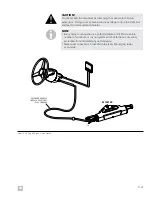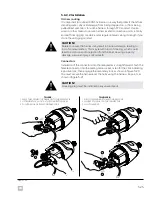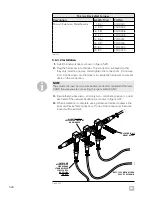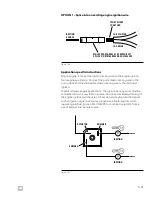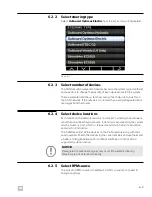
5-25
EN
5.6.2.2 Installation
Harness routing
It is important to route all CAN1 harnesses in a way that protects them from
standing water, physical damage, from being stepped on, or from being
pulled. Best practice is to run the harness through PVC conduit. Use tie
wraps or other means to secure harnesses at all connection points, at entry
and exit from rigging conduit, and at regular intervals along its length if you
do not have rigging conduit.
CAUTION!
Failure to secure the harness may result in harness damage, leading to
loss of communication. This may result in loss of steering, which could
lead to a collision and/or ejection from the boat, causing property
damage, personal injury, and/or death.
CAUTION!
A sealing plug must be installed in any unused ports.
Connectors
Installation of the connectors into the receptacles is straightforward. Push the
female connector into the mating male socket, listen for the click indicating
a positive lock, then engage the secondary lock as shown in figure 5-20.
You must secure the harnesses at the helm using the harness tie points, as
shown in figure 5-21.
TO LOCK:
1. PRESS THE CONNECTOR FIRMLY ONTO THE RECEPTACLE
2. LISTEN FOR THE “CLICK” AS THE CONNECTOR LOCKS
3. PUSH TO ENGAGE THE SECONDARY LOCK
TO UNLOCK:
1. PUSH TO DISENGAGE THE SECONDARY LOCK
2. SQUEEZE TO UNLATCH THE CONNECTOR
3. PULL TO REMOVE
Figure 5-20.
Содержание OPTIMUS 360
Страница 36: ...4 6 EN This page left intentionally blank ...
Страница 68: ...5 32 EN This page left intentionally blank ...
Страница 80: ...A 2 EN This page left intentionally blank ...
Страница 82: ...A 4 EN This page left intentionally blank ...
Страница 84: ...A 6 EN This page left intentionally blank ...
Страница 86: ...A 8 EN This page left intentionally blank ...
Страница 88: ...A 10 EN This page left intentionally blank ...
Страница 90: ...A 12 EN This page left intentionally blank ...











